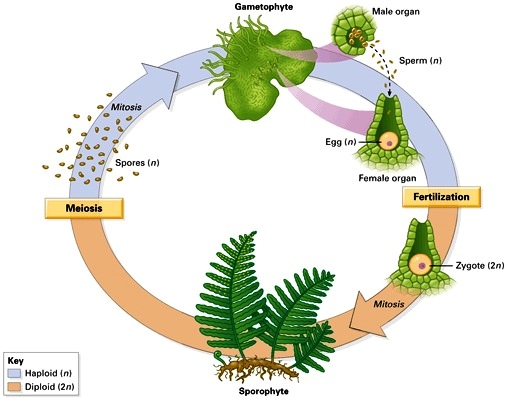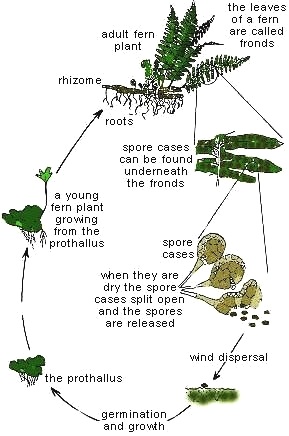Pteridophytes
Table of Content |
 - The pteridophytes (Gk. Pteron = feather and phyton = plants ;
- The pteridophytes (Gk. Pteron = feather and phyton = plants ; means plants with feather like fronds or ferns).
means plants with feather like fronds or ferns).
- They are flowerless, seedless, spore producing vascular plant which have successfully invaded the land.
- Pteridophytes represent an intermediate position between bryophytes and spermatophytes (Gymnosperm and Angiosperm).
- It was classified by Carolus Linnaeus (1754) under the class cryptogamia.
- They are also called vascular cryptogams.
- The group has a long fossil history. It is the most primitive group that flourished in Devonian and Carboniferous periods of Palaeozoic Era.
Characteristics of Pteridophytes
-
The Pteridophytes include horsetails and ferns.
-
Evolutionarily, they are the first terrestrial plants to possess vascular tissues - xylem and phloem.
-
The pteridophytes are found in cool, damp, shady places though some may flourish well in sandy soil conditions.
-
In pteridophytes, the main plant body is a sporophyte which is differentiated into true root, stem and leaves.
-
These organs possess well differentiated vascular tissues.
-
The leaves in pteridophyta are small (microphylls) as in Selaginelia or large (macrophylls) as in ferns.

-
The sporophytes bear sporangia that are subtended by leaf-like appendages called sporophylls.
-
In some cases sporophylls may form distinct compact structures called strobili or cones (Selaginella, Equisetum).
-
The sporangia produce spores by meiosis in spore mother cells.
-
The spores germinate to give rise to inconspicuous, small but multicellular, free-living, mostly photosynthetic thalloid gametophytes called prothallus.
-
These gametophytes require cool, damp, shady places to grow. Because of this specific restricted requirement and the need for water for fertilisation, the spread of living pteridophytes is limited and restricted to narrow geographical regions.
Reproduction
-
The gametophytes bear male and female sex organs called antheridia and archegonia, respectively.
-
Water is required for transfer of antherozoids the male gametes released from the antheridia, to the mouth of archegonium.
-
Fusion of male gamete with the egg present in the archegonium result in the formation of zygote.
-
Zygote thereafter produces a multicellular well differentiated sporophyte which is the dominant phase of the pteridophytes.
-
In majority of the pteridophytes all the spores are of similar kinds; such plants are called homosporous.

-
Genera like Selaginella and Salvinia which produce two kinds of spores, macro (large) and micro (small) spores, are known as heterosporous.
-
The megaspores and micros pores germinate and give rise to female and male gametophytes, respectively.
-
The female; gametophytes in these plants are retained on the parent sporophytes for variable periods.
-
The development of the zygotes into young embryos takes place within the female gametophytes.
-
This event is a precursor to the seed habit considered an important step in evolution.
Affinities of Pteridophytes:
The pteridophytes occupy an intermediate place between bryophytes and spermatophytes. They represent affinities with both the groups.
Similarities with Bryophytes
(a) Both have terrestrial mode of life.
(b) Water is indispensable for the process of fertilization.
(c) Male gametes are flagellated.
(d) The structure and ontogeny of sex organs i.e. antheridium and archegonium is based on similar pattern.
(e) Both the groups have definite alternation of sporophytic and gametophytic generations.
(f) Sexual reproduction is of oogamous type. Zygote is retained within the venter of archegonium to form embryo.
(g) Sex organs are surrounded by sterile jacket.
(h) The young sporophyte is partially or wholly dependent on the gametophyte for nourishment.
Similarities with Spermatophytes
(a) In both the cases, sporophytic plant body is large, independently existing and dominant phase of life cycle.
(b) The plant body is differentiated into true stem, leaves and roots.
(c) Vascular tissue is present.
(d) Spores are produced inside the sporangia.
(e) Presence of distinct alternation of generations.
(f) Process of photosynthesis is mainly confined to leaves. Stomata are present on the leaves.
|
Classification
-
Eichler (1883) classified the plant kingdom into Cryptogamia and Phanerogamia.

-
The Cryptogamia was further divided into Thallophyta, Bryophytes and Pteridophyta.
-
Engler (1909) included Bryophyta and Pteridophyta under Embryophyta.
-
Sinnott (1935) introduced the term Tracheophyta.
-
A year later Eames (1936) classified Tracheophyta into four groups namely, Psilopsida Lycopsida, Sphenopsida and Pteropsida, and Pteropsida into Filicinae, Gymnospermae and Angiospermae.
-
Smith (1938) classified pteridophytes into four classes namely Psilophytineae, Lycopodineae, Equisetineae and Filicineae.
-
Oswald and Tippo (1942) classified pteridophytes in to four sub-phyla.
(i) Psilopsida
(ii) Lycopsida
(iii) Sphenopsida
(iv) Pteropsida
Salient Features of Sub-Phyla
(i) Sub-phylum : Psilopsida
(a) These are the oldest known vascular plants, most of them (except Psilotum and Tmesipteris) are fossils.
(b) Plant body is relatively less differentiated.
(c) Roots are absent, instead dichotomously branched rhizome is present.
(d) Aerial axis is either naked or have small spirally arranged leaves.
(e) Sporangia are cauline (i.e., directly borne on the axis or stem); they are lateral or terminal in position. e.g., Psilotum, Tmesipteris.
(ii) Sub-Phylum : Lycopsida
(a) Plant body is differentiated into root, stem and leaves.
(b) Leaves small (i.e., microphyllous) with a single unbranched vein.
(c) Sporangia develop in the axil of the sporophylls.
(d) Sporophylls generally form compact strobili. e.g., Lycopodium, Selaginella, etc.
(iii) Sub-Phylum : Sphenopsida
(a) Stem differentiated into nodes and internodes.
(b) Leaves microphyllous, present in whorls at each node.
(c) Sporangia are borne on the sporangiophores which form compact cones at the apex of the fertile branches. e.g., Equisetum.
(iv) Sub-Phylum : Pteropsida
(a) Plant body well differentiated into root, stem and leaves.
(b) Leaves megaphyllous, pinnately compound.
(c) Sporangia develop on the ventral surface of the sporophylls, usually aggregated into sori. e.g., Dryopteris, Pteris, Pteridium, Polypodium, etc.
Selaginella
-
Selaginella is commonly called the little club moss or spike moss. Selaginella is mainly found in damp shaded places.
-
The plant body is sporophytic (2n), which is an evergreen and delicate herb having adventitious roots.
-
The plants show great variation in their morphology.
-
Some species are prostrate growing upon the surface (e.g., S.kraussiana), some are suberect (e.g., S.trachyphylla) and others are climbers (e.g., S.allegans).
-
The stem is covered with four rows of small leaves, out of these two rows are of smaller leaves and two of large leaves species with dimorphic leaves such as S.kraussiana, S.helvetica, S.lepidophylla, S.chrysocaulos etc.
-
Reproduction takes place by vegetative and sexual (by spores) method.

(1) Vegetative reproduction: It is of rare occurrence and may takes place by following methods:
(i) Fragmentation: It occurs during very' humid conditions. Some branches act as adventitious branches, which get separated from the plant and give rise to new Selaginella plants, e.g., in S.rupestris.
(ii) By resting buds: In some cases, terminal leaves get overlapped and become fleshy and form resting buds, which are means of vegetative reproduction, e.g., in S.chrysocaulos.
(iii) By tubers: In S.chrysorrhizos, some branches penetrate into substratum and at terminal ends swell to form tubers, which give rise to new plants.
(iv) By apogamy: In some cases, development of sporophyte occurs directly from gametophyte without intervention of sex organs, it is called apogamy and such plants are genetically haploid.
(2) Sexual reproduction: The reproductive structure in Selaginella is strobilus or spike. It is a sessile structure and develops at the terminal ends of the branches and its length varies from 1/4th of an inch to 2-3 inches in different species
-
The sporangia are of two types:
(i) Megasporangia: Borne on megasporophylls. Megasporangium is pale greenish and contains chalky white, yellow or orange megaspores.
The megasporangium is four-lobed structure with a 2-layered jacket, one layer of tapetum and a large number of microspore mother cell. However, only one megaspore mother cell is functional. After meiosis it produces 4 megaspores out of which 1-3 may degenerate. In S.rupestris, there is only a single megaspore.
(ii) Microsporangia: Borne on microsporophylls having a large number of small spores. Thus Selaginella is heterosporous. Microsporangium is pale yellow, oval or spherical body, with 2-layered jacket, one layered tapetum and a number of microspore mother cells which undergo meiosis and form haploid microspores. The main body consists of a wall having two layers, inside which are present numerous small microspores (400-2000).
Fern
-
Ferns live in moist, cool and shady places.

-
They are perennial and evergreen.
-
Fern Dryopteris filixmas is commonly known as Beech fern or Male shield fern or Hay scented fern.
-
Fern plant is sporophytic (2n) with an underground rhizomatous stem, large aerial leaves or fronds and adventitious roots.
-
Rhizome is sparingly branched in Dryopteris, moderately branched in Pteris and Adiantum (Adiantum is commonly called "Maiden hair fern" or walking fern because it propagates vegetatively by its leaf tips) and profusely branched in Pteridium.
-
The younger leaf is called like a spring from apex downwards are called circinate venation. Younger parts of leaves and rhizome are surrounded by brown hairy structures called scales or ramenta. Leaf bases are persistent.
-
Vegetative reproduction can occur through fragmentation or rhizome and adventitious buds and these on separation gives rise to new fern plant.
-
Sexual reproduction takes place through spores.Spores are born in sporangia.
-
The spores are of one kind only (homosporous).
-
When leaves are mature they bear groups of sori on the-under surface of fertile pinnae. Such fronds are called sporophylls.
 Economic Importance
Economic Importance
(i) Ornamental value: Many ferns are grown as ornamental plants in gardens for their large, Show and graceful foliage. e.g., species of Lycopodium, Nephrolepis, Selaginella, Lygodium, Anemia, Cyathea etc.
(ii) Medicines : An anthelmintic drug is obtained from the rhizomes and petioles of the fern Dryopteris. Lycopodium clavatum is used in skin diseases. Equisetum arvense has diuretic properties.
(iii) Food : The sporocarps of Marsilea are rich source of starch and used by tribals for their nutritive value.
(iv) Soil conservation : Plants like Selaginella are useful in soil conservation.
Question 1: Zoodiogama includes –
(1) Cymnosperms and pteridophyta
(2) Dicots, monocots, gymnosperm
(3) Bryophyta and pteridophyta
(4) Only Thallophyta
Question 2: Embryophyta includes –
(1) Angiosperms only
(2) Algae and fungi
(3) Bryophyta & Pteridophyta
(4) All plants except Thallophyta
Question 3: Siphonogama includes –
(1) Bryophyta and thallophyta
(2) Pteridophyta & bryophyta
(3) Gymnosperm & angiosperm
(4) Thallophyta and gymnosperm
Question 4: According to Eichler cryptogamia includes –
(1) Gymnosperm and Angiosperm
(2) Thallophyta and Gymnosperm
(3) Thallophyta, Bryophyta and Pteridophyta
(4) Only angiosperm
Question 5: Fertilization by zoodiogamy occurs in –
(1) Cryptogams
(2) Phanerogams
(3) Only bryophyta


| Q.1 | Q.2 | Q.3 | Q.4 | Q.5 |
| 3 | 4 | 3 | 3 | 1 |
Related Resources
-
Click here to refer the Useful Books of Biology for NEET (AIPMT)
-
Click here for Study Material on Amphibia
To read more, Buy study materials of Plant Kingdom comprising study notes, revision notes, video lectures, previous year solved questions etc. Also browse for more study materials on Biology here.
View courses by askIITians


Design classes One-on-One in your own way with Top IITians/Medical Professionals
Click Here Know More

Complete Self Study Package designed by Industry Leading Experts
Click Here Know More

Live 1-1 coding classes to unleash the Creator in your Child
Click Here Know More






